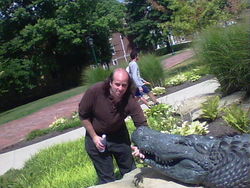Adam J Pierce
From Santa Fe Institute Events Wiki
| GSSS 2016 |
Adam J Pierce , University of Akron - Akron OH USA
A rural Pacific Northwest native, Adam Jason Pierce spent his earliest years surrounded by hillside and mountain forests, the nearest neighbors blocks away. His time in the woods sparked and cemented the idea that everything is always networked. Pierce is a Biomimicry fellow with Great Lakes Biomimicry and a University of Akron Integrated Bioscience PhD candidate, funded by the GAR Foundation. With faculty and staff at the National Inventors Hall of Fame: Center for STEM Learning®, in Northeast Ohio, Pierce is working to develop scalable biomimicry curriculum for grades 5-12. He is formulating plans to design and launch community groups for members to come together to apply biomimicry to solve local problems.
Pierce earned a BA in Environmental Studies and Creative Writing with concentrations in Sustainable Design and Organic Architecture from The Evergreen State College. In 2012 he received a Gilman Scholarship research grant to spend four months of summer studying in Europe. He focused on the new field of Baubotanik (the architectural field under development at Stuttgart: guiding living plants to create the structural elements of buildings), as well as volunteering on many organic farms throughout Europe with his family. This allowed him to explore the practical application of organic farms throughout Europe and especially in Küçükkuyu, Turkey.
For his dissertation research, Pierce is considering using biomimicry to advance the field of organic architecture. Organic architecture is the cross-section of planning, designing, and creating human-made living spaces that, ideally, function as well as forests, prairies, or tidal zones. Living systems such as these are suitable models, as they succeed in recycling waste, distributing needed resources, improving local conditions, and so on, all in a healthful, regulated way.

